"I am going back to thinking about my 66 Chevelle
420 Megablower 8-1 496
Edelbrock Perf RPM rectangular port bowl blended heads
Lunati hyd roller custom grind 114lca 109icl 240/245 @ .050 .647 lift
Dual 650 Holley dp carbs manifold ref with QFT block and 4 corner idle
MSD 6al locked dist at 32 degrees
TKO600 4.11 gear 29" tires
idle 1000rpm 10" vacuum
Cruising in 5th at 2000-2200rpm 14" vacuum
145 cranking compression
4% leak down cold
power band desired 1800-5800
I have been fighting this thing being doggy at cruising speed and blown small block level power on the gas. Had a lot of good help on this and other sites.
I finally cranked the boost up from 1-1 to 13% overdrive. That made a huge difference and it really responded to 35 degrees timing jump. I can finally mash the gas at 5 mph and spin the big Mickey radials in first gear. I have always blamed the cam but it is in the ball park and some cam guys suggest a lot smaller grind for low speed cruising while some have told me it is either installed wrong or I'm missing something. I am beginning to think the power improvements with timing and boost are telling me the thing really wants more of both to be a real torque monster. Lunati said they can knock some lift and duration out of the cam but how much is the question. Any opinions on why this engine seems to be so different than the rest I read about? I expected it to be a brute instead of a wimp"
my first thought here is if you have
"idle 1000rpm 10" vacuum
Cruising in 5th at 2000-2200rpm 14" vacuum"
theres something wrong with the current supercharger OR you really need a larger more efficient supercharger on that 496 BBC
the whole idea of supercharging infers your packing a greater volume of fuel/air mix into the cylinders to increase power levels by burning a greater concentration of fuel and air in each combustion sequence.
vacuum should start dropping a bit by 2200rpm as the rpms build, in fact ideally you should see pressure start to increase,by 2000rpm it is not currently increasing boost, in fact the increase vacuum reading indicates the current systems RESTRICTING AIR FLOW.
ID be looking at a roots 6-71, or 8-71 or centrifugal supercharger,ID also suggest taking a few pressure reading on the exhaust as rpms increase to verify your not fighting a restrictive exhaust
knowing the plenum vacuum readings, and exhaust back pressure gives you a great piece of useful information, ID be expecting the supercharger to be at a very low (1-2 PSI) pressure range, by 2200rpm, certainly not finding INCREASED vacuum, a cam with a wider LSA and a bit less duration would also trap more compressed fuel/air mix, if I would have selected the combo components I would have gone with a centrifugal supercharger and this crane hydraulic roller cam.
the cam you list has only 5 degrees more exhaust duration, the cam below has a bit less intake duration but a bit more effective exhaust duration IN RELATION TO INTAKE DURATION at 8 degrees, so the intake valve seating traps more combustible gasses and the slightly increased exhaust timing in relation to the intake duration should increase scavenging efficiency. remember your running a supercharger and trying to maximize power below 6000rpm, which will be close to both the hydraulic valve train and piston speed limitations for long term durability
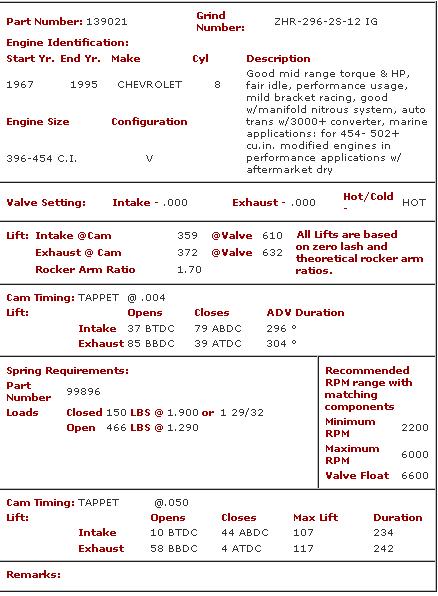
viewtopic.php?f=56&t=495
http://www.procharger.com/
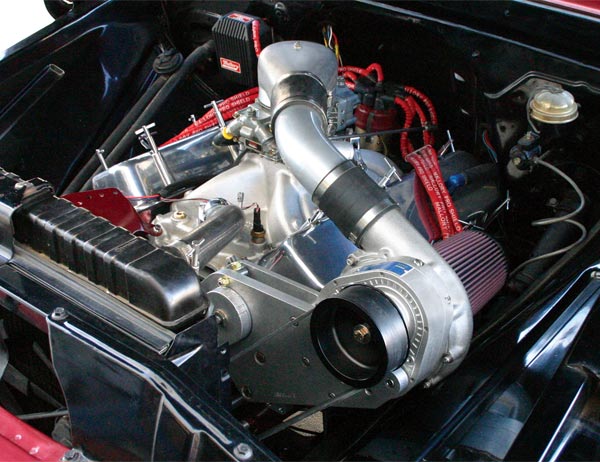
http://www.summitracing.com/parts/wnd-7488p/media/images
http://www.ehow.com/how_7953457_size-cu ... arger.html
http://www.duccutters.com/pdf/BoostChart.pdf
http://www.vortechsuperchargers.com/scspecsheet.php
http://www.holley.com/data/TechService/ ... 20Info.pdf

much better match to a 496 BBC
https://www.carid.com/weiand/8-71-s...MIhuaYkZ2m3AIVC7XACh0IKA_UEAQYBSABEgK_kPD_BwE
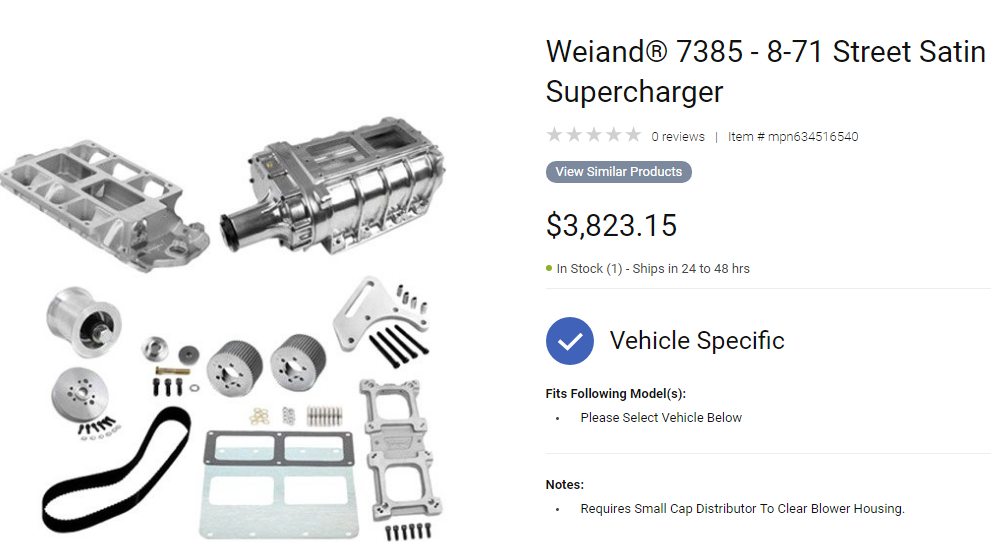
https://www.procharger.com/automoti...eted/gm-carbureted-aftermarket-efi/sbbb-chevy
https://www.procharger.com/automoti...t-efi/sbbb-chevy#/p-1x-and-d-1x-superchargers
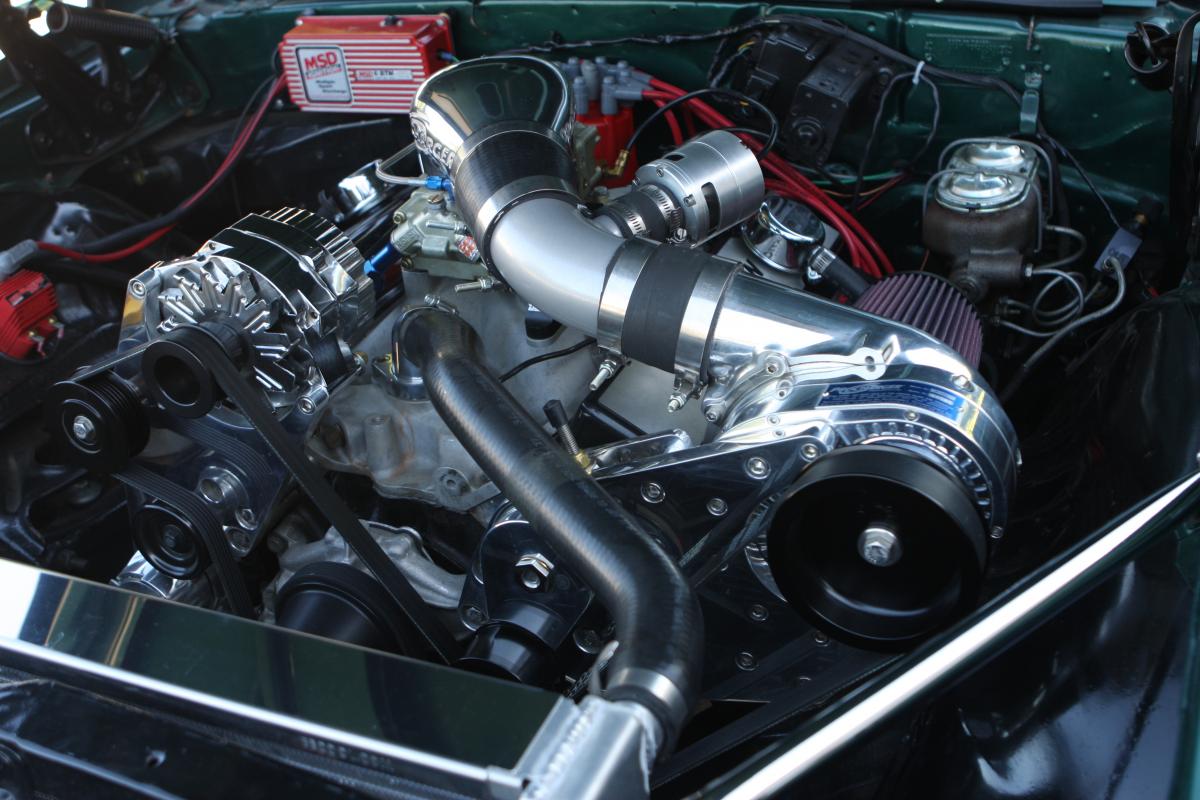
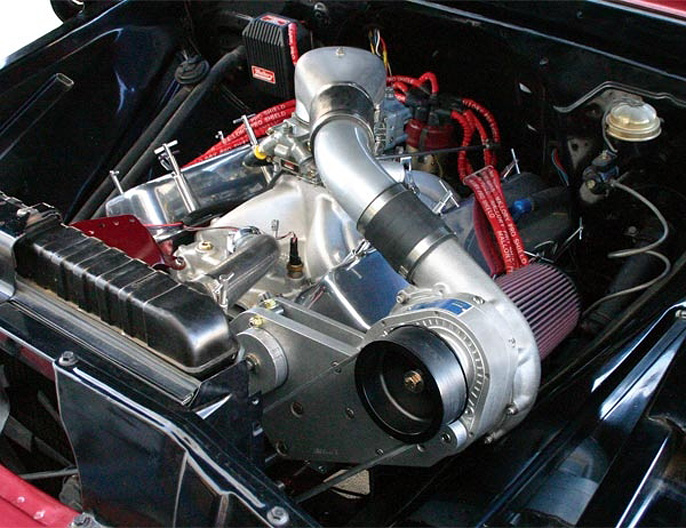
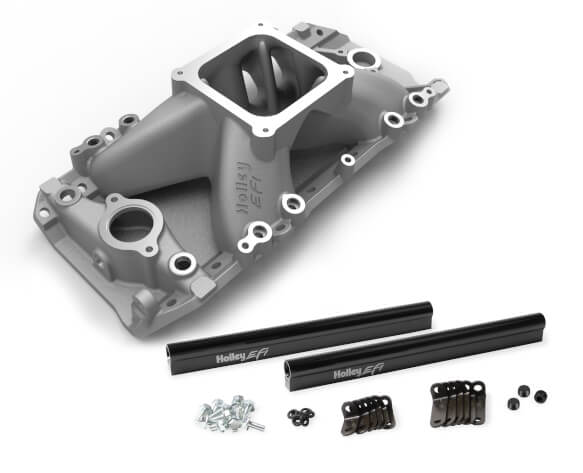
https://www.holley.com/products/int...MIgbncx6Cm3AIVFrbACh13kQbIEAQYBCABEgJwy_D_BwE
https://www.powerperformancenews.com/tech/grade-on-a-curve-choosing-the-right-supercharger/
http://www.superchargersonline.com/index.php?main_page=page&id=53
https://www.jegs.com/s/tech-article...chargers+-+Blowers+-+Roots+Type+-+Centrifugal
http://www.superchevy.com/how-to/engines-drivetrain/0610ch-superchargers/
https://www.carthrottle.com/post/what-do-supercharger-capacity-ratings-actually-mean/
420 Megablower 8-1 496
Edelbrock Perf RPM rectangular port bowl blended heads
Lunati hyd roller custom grind 114lca 109icl 240/245 @ .050 .647 lift
Dual 650 Holley dp carbs manifold ref with QFT block and 4 corner idle
MSD 6al locked dist at 32 degrees
TKO600 4.11 gear 29" tires
idle 1000rpm 10" vacuum
Cruising in 5th at 2000-2200rpm 14" vacuum
145 cranking compression
4% leak down cold
power band desired 1800-5800
I have been fighting this thing being doggy at cruising speed and blown small block level power on the gas. Had a lot of good help on this and other sites.
I finally cranked the boost up from 1-1 to 13% overdrive. That made a huge difference and it really responded to 35 degrees timing jump. I can finally mash the gas at 5 mph and spin the big Mickey radials in first gear. I have always blamed the cam but it is in the ball park and some cam guys suggest a lot smaller grind for low speed cruising while some have told me it is either installed wrong or I'm missing something. I am beginning to think the power improvements with timing and boost are telling me the thing really wants more of both to be a real torque monster. Lunati said they can knock some lift and duration out of the cam but how much is the question. Any opinions on why this engine seems to be so different than the rest I read about? I expected it to be a brute instead of a wimp"
my first thought here is if you have
"idle 1000rpm 10" vacuum
Cruising in 5th at 2000-2200rpm 14" vacuum"
theres something wrong with the current supercharger OR you really need a larger more efficient supercharger on that 496 BBC
the whole idea of supercharging infers your packing a greater volume of fuel/air mix into the cylinders to increase power levels by burning a greater concentration of fuel and air in each combustion sequence.
vacuum should start dropping a bit by 2200rpm as the rpms build, in fact ideally you should see pressure start to increase,by 2000rpm it is not currently increasing boost, in fact the increase vacuum reading indicates the current systems RESTRICTING AIR FLOW.
ID be looking at a roots 6-71, or 8-71 or centrifugal supercharger,ID also suggest taking a few pressure reading on the exhaust as rpms increase to verify your not fighting a restrictive exhaust
knowing the plenum vacuum readings, and exhaust back pressure gives you a great piece of useful information, ID be expecting the supercharger to be at a very low (1-2 PSI) pressure range, by 2200rpm, certainly not finding INCREASED vacuum, a cam with a wider LSA and a bit less duration would also trap more compressed fuel/air mix, if I would have selected the combo components I would have gone with a centrifugal supercharger and this crane hydraulic roller cam.
the cam you list has only 5 degrees more exhaust duration, the cam below has a bit less intake duration but a bit more effective exhaust duration IN RELATION TO INTAKE DURATION at 8 degrees, so the intake valve seating traps more combustible gasses and the slightly increased exhaust timing in relation to the intake duration should increase scavenging efficiency. remember your running a supercharger and trying to maximize power below 6000rpm, which will be close to both the hydraulic valve train and piston speed limitations for long term durability

viewtopic.php?f=56&t=495
http://www.procharger.com/

http://www.summitracing.com/parts/wnd-7488p/media/images
http://www.ehow.com/how_7953457_size-cu ... arger.html
http://www.duccutters.com/pdf/BoostChart.pdf
http://www.vortechsuperchargers.com/scspecsheet.php
http://www.holley.com/data/TechService/ ... 20Info.pdf

much better match to a 496 BBC
https://www.carid.com/weiand/8-71-s...MIhuaYkZ2m3AIVC7XACh0IKA_UEAQYBSABEgK_kPD_BwE

https://www.procharger.com/automoti...eted/gm-carbureted-aftermarket-efi/sbbb-chevy
https://www.procharger.com/automoti...t-efi/sbbb-chevy#/p-1x-and-d-1x-superchargers
an even better option in my opinion , requiring less hood clearance, would be a centrifugal supercharger with inter-cooler ( inter-cooler not shown in this picture) and a throttle body and direct port injection is also an option.The numbers related to these blower sizes, such as 142, 177, and 256, relate to the amount of air in cubic inches that is pumped by the blower in one blower revolution. The 6-71 and 8-71 designations refer to the original GMC diesel engines. Table 2 shows the amount of air per blower revolution the Weiand blowers pump.
TABLE 2: Supercharger Volumes
Supercharger Type Approximate CID or
Air Per Revolution
Pro-Street 142 142
Pro-Street 177 177
Pro-Street 256 256
Weiand 6-71 411
Weiand 8-71 436
Weiand 10-71 469
Weiand 12-71 497
Weiand 14-71 522
In selecting the proper supercharger for your application, you also need to take into consideration how you plan to drive your vehicle and the approximate boost level desired. How you plan to drive your vehicle is important because you can set up your blower to be more efficient at high engine speeds or more efficient at low engine speeds, or you can arrange for the best compromise for the full engine rpm range.
To run boost levels from 6 to 10 pounds we recommend the following:
Forged blower pistons with a static compression ratio of 7.5:1
For maximum boost and horsepower applications (12 pounds or more), we recommend the following engine specifications:
- Steel crankshaft
- Four bolt main caps
- Steel harmonic dampener
- Stainless steel valves
- Three angle valve job
- More aggressive camshaft
- Roller rockers
- Ported and polished heads
- Steel rods with good rod bolts
- Chromoly push rods
- High output ignition
- Weiand high flow water pump (cast iron or aluminum available - see our complete water pump section for applications)
- Minimum of a 2-1/2" diameter dual exhaust with headers. Recommended primary tube diameters and collector sizes are:
- Small Blocks: 1-5/8" to 1-3/4" with 3" collectors
- Big Blocks: 1-7/8" to 2' with 3-1/2" collectors
- High quality forged or billet crankshaft
- Four bolt main caps with quality bolts or studs
- Steel harmonic balancer or crank hub
- High quality steel rods (H or I beam)
- Forged blower pistons
- O-ringing the block (mandatory)
- Severe duty stainless steel valves or iconel
- Fully ported and polished heads
- Solid or roller cam designed for high boost
- Roller rockers
- Chromoly push rods
- High output ignition management system or magneto
- Blueprinted carburetors or fuel injection
- High octane race fuel (112+ rating)
- Minimum of a 3" diameter dual exhaust with free flowing street/race mufflers and large tube headers.
- Recommended primary tube diameters and collector sizes are:
- Small Blocks: 1-7/8" to 2" with 3-1/2" collectors Big Blocks: 2-1/8" to 2-1/4", with 4" collectors
- Maximum effective compression ratio on gas not to exceed 24:1
- It's important to realize that there are no hard and fast rules and the suggestions made here are general in nature.


https://www.holley.com/products/int...MIgbncx6Cm3AIVFrbACh13kQbIEAQYBCABEgJwy_D_BwE
https://www.powerperformancenews.com/tech/grade-on-a-curve-choosing-the-right-supercharger/
http://www.superchargersonline.com/index.php?main_page=page&id=53
https://www.jegs.com/s/tech-article...chargers+-+Blowers+-+Roots+Type+-+Centrifugal
http://www.superchevy.com/how-to/engines-drivetrain/0610ch-superchargers/
https://www.carthrottle.com/post/what-do-supercharger-capacity-ratings-actually-mean/
Last edited by a moderator:
